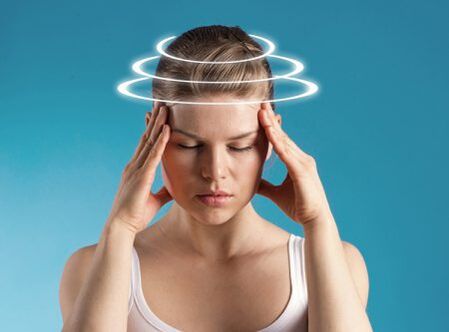Cervical osteochondrosis in recent years has become one of the major human health problems. Decades ago, the disease was considered by many in the elderly because of age -related changes in the intervertebral cartilage. Nowadays, osteochondrosis of the neck is increasingly being diagnosed in adolescents, even adolescents.

Who can get cervical osteochondrosis?
Computers and TVs have entered almost every home. Prolonged work and games at the computer, hours of watching television do not have the best effect on the cervical spine.
Those who spend a lot of time driving a car are also prone to this disease. Heavy physical energy or, conversely, inactivity (physical inactivity), overweight and some diseases, for example, metabolism, can also provoke the appearance of osteochondrosis of the neck.
How and why does this disease appear?
With cervical osteochondrosis, there is a gradual destruction of intervertebral cartilage. Therefore, there is a violation of the normal position of the vertebrae that are interconnected with each other.
Also, with the long -term course of the disease, the ducts and spinal nerves located in the ducts of the cervical vertebrae are involved in pathological processes.
The main manifestations of neck osteochondrosis

For a long time, the disease may not manifest itself in any way. Sometimes there is just discomfort in the neck, recurrent pain or cramping. As a rule, the majority of patients at this stage do not go to the doctor.
Later, as the disease progresses, manifestations of the disease appear in the cervical spine. Most often, osteochondrosis of the neck is indicated by the following symptoms:
- It hurts. Pain occurs most often in the neck, sometimes in the clavicle, shoulders and upper limbs. The pain may be accompanied by sensory disturbances (numbness, "creeping creeps", etc. ).
- Cracks on any movement of the neck.
- Dizziness.
- Headache. They usually do not respond to conventional painkillers.
- Imbalance and other symptoms.
This and other manifestations of the disease make the sick person still seek help from a neuropathologist. However, they already show an active degenerative process in the cervical spine.
How to prevent the development of osteochondrosis of the neck?
First of all, you have to lead an active lifestyle. You need to play sports or at least do daily exercise in the morning. A major role in disease prevention is assigned to the organization of a proper regime of work and rest.
While working out, which is associated with long forced body positions, you should rest periodically.
During this break, it is very useful to do a gentle warm -up of the cervical muscles and massage this area yourself. Choose the right mattress and pillow for your night's sleep.
What if the disease has already appeared?

In addition to following the doctor’s recommendations for treating neck osteochondrosis, a few simple rules should be followed in daily life. Their attention will make it possible to minimize the frequency of this disease as much as possible:
- Daily implementation of recommended physiotherapy exercises.
- During inactive work, change body position every 30-50 minutes, resting for gymnastics for the neck.
- If possible, limit the time you work at the computer, watch TV and so on.
- Maintain proper body posture.
- Use orthopedic mattresses and pillows for sleeping.
- The car must have a hard seat with an adjustable headrest and a comfortable backrest seat.
- Try not to do heavy physical work, not to do sudden movements.
- If you need to lift a heavy item, you should first sit down and then pick it up.
- Do not carry a heavy bag on your shoulder. Backpacks should be used to carry items.
- You have to lose excess weight.
- Avoid hypothermia and drafts.
In case of acute pain in the neck, the effects of sharp heat (bath, sauna, etc. ) are contraindicated. Swimming is very helpful, especially on your back in a pool or open body of water.
Neck gymnastics complex
These exercises or similar sets are recommended to be done periodically during breaks at work. And not only for patients with osteochondrosis of the neck, but also for disease prevention. After all, exercises like this can not only relieve tension on the cervical muscles, but also improve efficiency, concentration, and improve memory:
- Lower your chin to your neck, slowly turning your head in both directions. Do it five times in each direction.
- Lift your chin slightly, turning your head in each direction. Repeat five times.
- Tilt your head to the right, trying to reach a shoulder that fits your ears. Do the same for the opposite side. Repeat five times.
- Chin straight, both hands pressed to the back of the head. Press the back of the head on the hands, overcoming the resistance of the cervical muscles, for seven seconds. Repeat three more times.
- Press with your forehead on the palms of the hands that do not move for seven seconds. Repeat three more times.
- Place the palm of your right hand on the right temple and press your head against it, tensing your neck muscles for seven seconds. Do the same on the other side. Repeat three times.
- Head straight. Try tilting the head forward, overcoming the endurance of the tense cervical muscles. Repeat five times.
- Tilt your head back, trying to pull your chin up. Repeat five times.
- Interval fingers and place under the chin. Press them with a still hand, stretching the cervical muscles for seven seconds. Repeat three more times.
Breathe easily, evenly and calmly while exercising. Don't push yourself too hard. If you experience a slight discomfort (pain or numbness, dizziness, etc. ), you should stop exercising and inform your doctor.
How to sleep properly?

In dreams, we spend an average of a third of our lives. Therefore, it is important to think about these nuances in more detail. Ideally, you should buy orthopedic mattresses and especially pillows.
If this is not possible, here are some tips for choosing it:
- The mattress must be firm and durable. In the acute phase of the disease, it is recommended to place additional protectors or wide boards under the mattress.
- Pillows must be small and soft. It can only support the head and neck. The shoulders are on the outside. In case of this disease, a special roller or a small bag containing warm sand in it can be placed under the neck. If the patient has signs of damage to the vertebral arteries, then a high, stiff pillow should be used. The height of the pillow also depends on the width of the patient's shoulders. Patients with cervical osteochondrosis cannot sleep completely without a pillow. This recommendation applies only to disease prevention.
- The sleeping position for neck osteochondrosis should be chosen on the back or on the side. Sleeping on the stomach is highly undesirable. If this is not possible, a small flat pillow should be placed under the ribs.
Modern treatment methods
All methods of treatment of neck osteochondrosis aim to improve the anatomical function of the discs and intervertebral joints, as well as the ligaments and bone tissue of the vertebrae. Symptomatic treatment is used, which aims to reduce the severity of the manifestations of the disease.
Acute phase of cervical osteochondrosis

With the increase of the disease, especially drug treatment is used. The main goal is to reduce the intensity of pain in the cervical spine.
If there is dizziness, headache and other symptoms that indicate the involvement of the vertebral arteries in the pathological process, appropriate corrective therapy is used.
Treatment in remission
After the acute manifestations subside, perhaps primary treatment of cervical spine osteochondrosis is carried out. This cannot be ignored. Indeed, accurate implementation of the recommendations of the attending physician during this period will reduce the frequency and intensity of disease exacerbation in the future. To do this, use:
- Sort.
- Manual therapy.
- Physiotherapy.
- Reflexology.
- Special physical therapy and gymnastics.
- Rehabilitation drug treatment: drugs that improve the condition of the cartilage of the intervertebral disc (chondroprotectors); vitamin therapy.
Of course, the complex of therapeutic effects should be carried out under the supervision of a physician.
Is it possible to get rid of neck osteochondrosis?
Osteochondrosis of the cervical spine is a long -term disease that causes many problems for patients. And, of course, we are all interested in the main question: how to get rid of cervical osteochondrosis?
Unfortunately, changes in the intervertebral cartilage and other anatomical structures of the cervical spine are irreversible.
However, careful adherence to all medical recommendations and complete lifestyle changes will allow you to forget about the pain in the neck for a long time, and sometimes even forever.



















